New 1981-2010 Averages being used this year.
Note: This publication is currently undergoing major revisions. The current publication will be replaced with a new publication based on stakeholder requirements and scientific advances. We expect to begin sharing details on this soon. If you have input on content, format, or publication frequency at any time, please contact us at cbrfc.webmasters@noaa.gov.Green Water Supply Outlook, April 1, 2012Green Water Supply Outlook, April 1, 2012
Contents
Green Summary

*Median of forecasts within each basin.
Upper Green Basin Conditions
The following conditions influenced this month's forecasts:
Precipitation:
Seasonal October through March
precipitation was 95 percent of average
in the Upper Green basin as a whole. March
precipitation was 50 percent of average.
Snow:
April 1st snow water equivalent was 85 percent of average in the basin as a whole. Low and mid elevation snowmelt
occurred due to much above average temperatures in March.
--- Upper Green basin
snow
water equivalent plot.
Streamflow:
March streamflow was near 110 percent of average.
Soil Moisture:
Modeled
soil
moisture states indicated near average to above average soil moisture conditions
last fall prior to snow accumulation.
Climate Forecasts:
Climate forecasts were not a factor because there is not a strong correlation
between La Nina conditions and winter precipitation in the Upper Green basin.
Forecast Summary:
March precipitation was much below average; however, seasonal precipitation in the Upper Green remains near average
as a result of above average precipitation in months other than December and March. As a result of early snowmelt
and much below average precipitation during March, the snow water equivalent decreased from near average to below average.
As a result, current April through July streamflow volume forecasts in the headwaters of the Upper Green have
decreased by 5 to 10 percent while forecasts for basins located in the Wyoming range (Ham's Fork) or the North Slope of the
Uintas decreased by 15 to 20 percent. Forecasts now range between 60 and 99 percent of average with a median value of 86 percent.
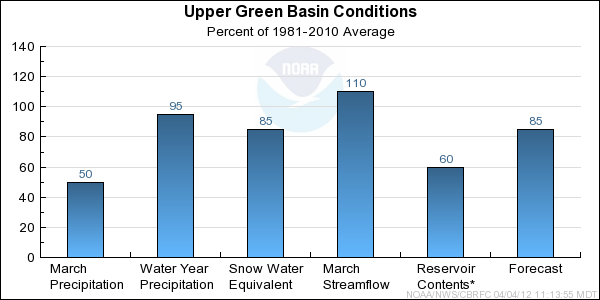
* Percent usable capacity, not percent average contents.
Click for multi-month Graph.
Yampa/White Basin Conditions
The following conditions influenced this month's forecasts:
Precipitation:
Seasonal October through March
precipitation was 70 percent of average
in the Yampa/White basin. March
precipitation was near 30 percent of average. This is the driest March on record for many
of the SNOTEL sites in the basin.
Snow:
April 1st snow water equivalent was 50 percent of average in the basin. Significant snowmelt occurred at low and mid elevations due to
much above average temperatures in March.
--- Yampa basin
snow
water equivalent plot.
Streamflow:
March streamflow was 140 percent of average as a result of the early snowmelt.
Soil Moisture:
Modeled
soil
moisture states indicated above average to much above average soil moisture conditions
last fall prior to snow accumulation.
Climate Forecasts:
Climate forecasts were not a factor in the forecasts because there is not a strong correlation
between La Nina conditions and winter precipitation in the Yampa/White basin.
Forecast Summary:
Due to much below average March precipitation, seasonal precipitation is now below average in the Yampa/White. Significant
snowmelt occurred during March due to the warm and dry conditions. By April 1st, the snow water equivalent had
been reduced from 80 percent of average on March 1st to near 50 percent of average. Many
of the SNOTEL locations have record or near record low snow water equivalent for this time of year.
As a result of the unusual dry and warm conditions in March, current April through July streamflow
volume forecasts have drastically decreased by 25 to 40 percent with the greatest decreases occurring in the Elkhead and Little
Snake basins. Forecasts now range between 38 and 59 percent of average with a median value of 54 percent.
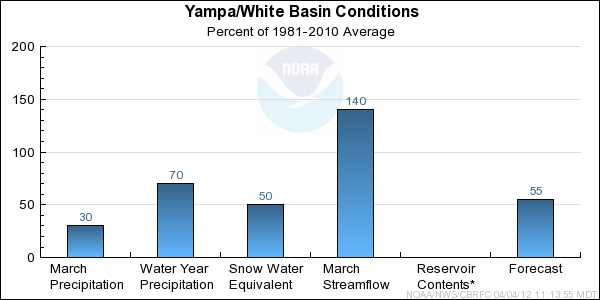
* Percent usable capacity, not percent average contents.
Click for multi-month Graph.
Duchesne Basin Conditions
The following conditions influenced this month's forecasts:
Precipitation:
Seasonal October through March
precipitation was 80 percent of average
in the Duchesne basin. March
precipitation was 60 percent of average.
Snow:
April 1st snow water equivalent was 55 percent of average in the basin. Low and mid elevation snowmelt
occurred due to much above average temperatures in March.
--- Duchesne basin
snow
water equivalent plot.
Streamflow:
March streamflow was near 120 percent of average over the basin.
Soil Moisture:
Modeled
soil
moisture states indicated much above average soil moisture conditions
last fall prior to snow accumulation.
Climate Forecasts:
Climate forecasts were not a factor in the forecasts because there is not a strong correlation
between La Nina conditions and winter precipitation in the Duchesne basin.
Forecast Summary:
March precipitation was much below average in the Duchesne and seasonal precipitation
still remains below average. Significant snowmelt occurred below 9000 feet due to the warm and dry
conditions in March. As of April 1st, the snow water equivalent over the basin as a whole had
been reduced from 70 percent of average on March 1st to 50 percent of average.
As a result, current April through July streamflow volume forecasts decreased by 5 to
10 percent in the higher elevation basins and by 20 to 30 percent in lower elevation basins such as Currant
Creek, Strawberry, and Big Brush drainages. Forecasts now range between 29 and 78 percent
of average with a median value of 62 percent.

* Percent usable capacity, not percent average contents.
Click for multi-month Graph.
Lower Green Basin Conditions
The following conditions influenced this month's forecasts:
Precipitation:
Seasonal October through March
precipitation was 80 percent of average
in the Lower Green basin. March
precipitation was 45 percent of average.
Snow:
April 1st snow water equivalent was 40 percent of average in the basin. Significant snowmelt
occurred due to much above average temperatures in March.
--- Lower Green basin
snow
water equivalent plot.
Streamflow:
March streamflow was near 90 percent of average.
Soil Moisture:
Modeled
soil
moisture states indicated near average to above average soil moisture conditions
last fall prior to snow accumulation.
Climate Forecasts:
Climate forecasts were not a factor in the forecasts because there is not a strong correlation
between La Nina conditions and winter precipitation in the Lower Green basin.
Forecast Summary:
March precipitation was much below average in the Lower Green and seasonal precipitation remains below average.
As a result of the snowmelt during March, the snow water equivalent is now much below average and
has been reduced from 65 percent on March 1st to 40 percent of average. As a result, current April through July streamflow
volume forecasts have decreased by 10 to 20 percent and now range between 39 and 59 percent of average
with a median value of 53 percent.
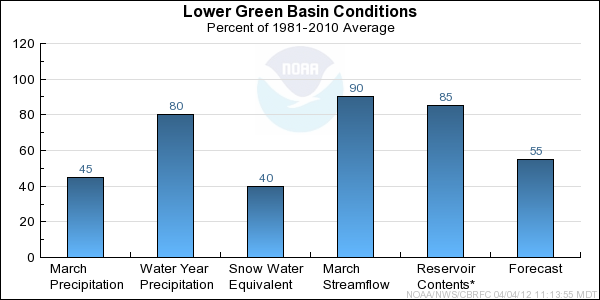
* Percent usable capacity, not percent average contents.
Click for multi-month Graph.
Differences between the full period forecasts and the residual forecasts may not exactly equal the actual observed volumes due to rounding conventions (see Definitions section).
Reservoir Monthly Inflow Forecasts
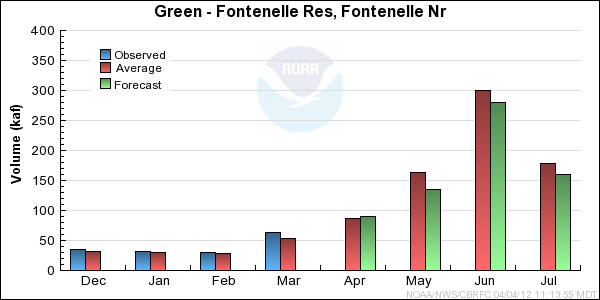
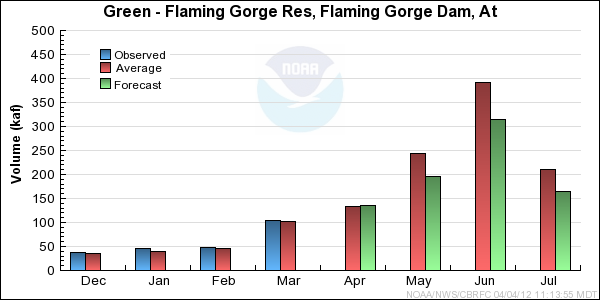
Monthly Streamflows
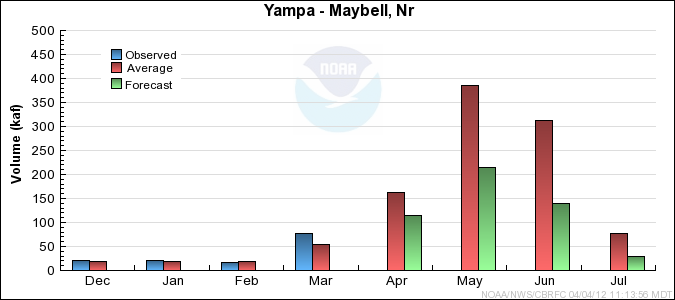
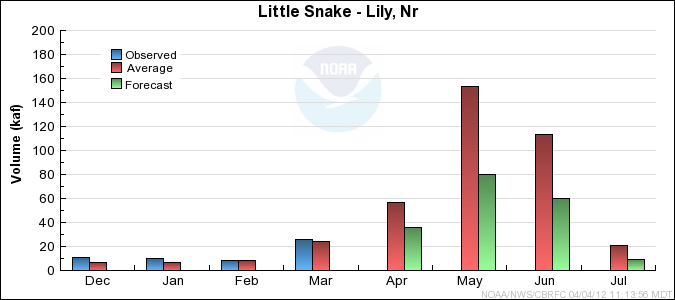
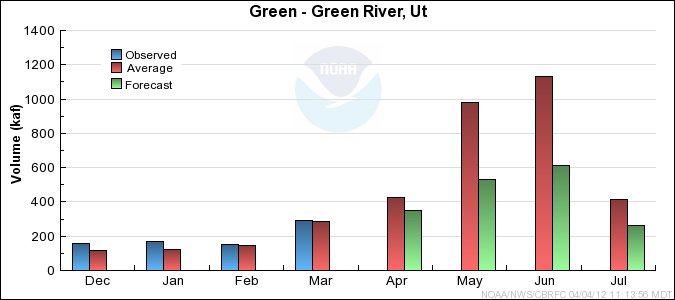
Precipitation Maps
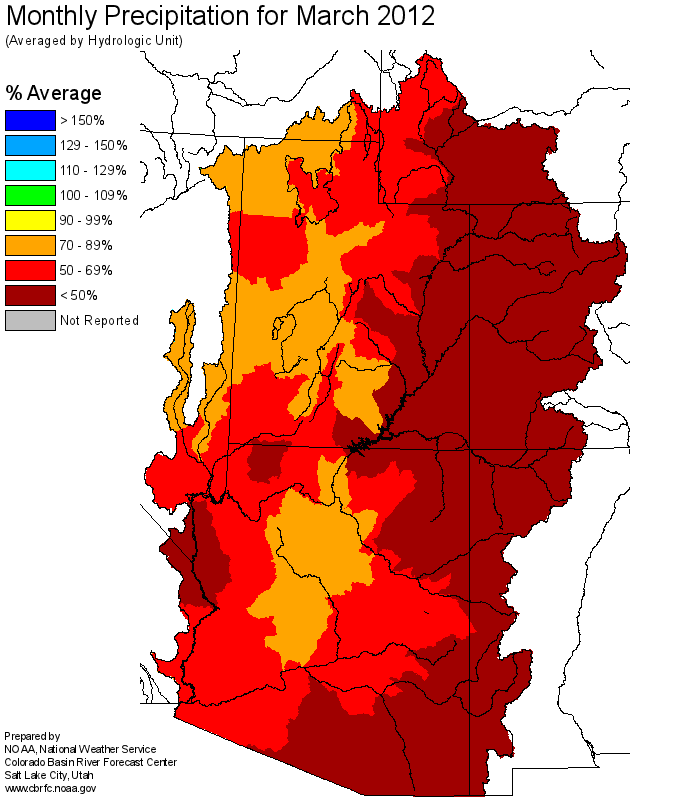
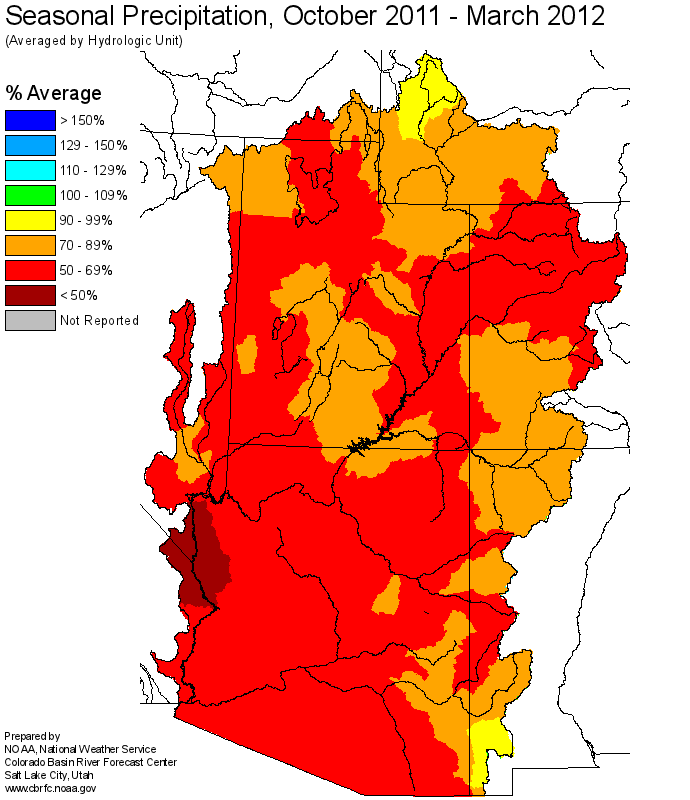
Hydrologist: Ashley Nielson













